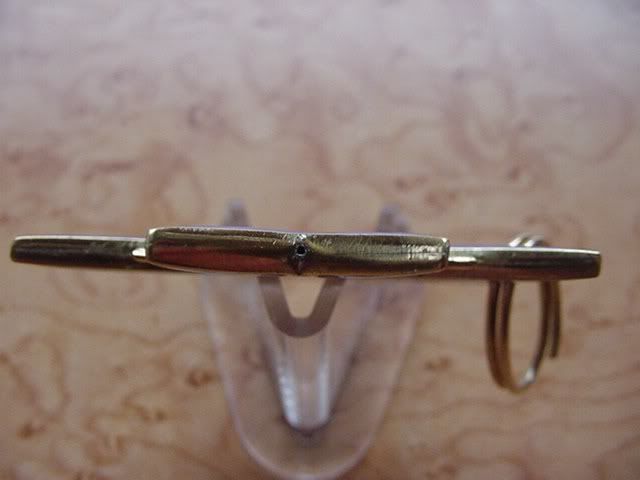Note the taper of the cross arm edges, incidentally.
This brings us to the issue of edges thickness, taper/shape, corrosion, and workmanship.
Here is a side-by-side of my cross and Sasha's:

Note in particular (arrows) how the eagles are set substantially within the edges of the cross by the wider, tapering arms. On Sasha's, they are nearly flush with the face of the cross. Mine is unmarked. There are dings and blemishes in the surface here and there, where I have tried to in vain to extract some sense of a mark. They are just surface injury (one is present on this arm, about where Sasha's was stamped. It is neither a stamp, nor a region abraded to remove one, just a small dent.)
Also, and I can't speak for Sasha's here, what appears to be small divots or gaps in the solder line in this image on mine, are actually slightly raised, dark colored forms of corrosion. There are no gaps in my solder line visible under conventional microscopy. The line itself is, where the gilding is absent. There are also a few pits in the surface to either side of it, as I have shown in some of the SEMs in prior threads.
This brings us to the issue of edges thickness, taper/shape, corrosion, and workmanship.
Here is a side-by-side of my cross and Sasha's:

Note in particular (arrows) how the eagles are set substantially within the edges of the cross by the wider, tapering arms. On Sasha's, they are nearly flush with the face of the cross. Mine is unmarked. There are dings and blemishes in the surface here and there, where I have tried to in vain to extract some sense of a mark. They are just surface injury (one is present on this arm, about where Sasha's was stamped. It is neither a stamp, nor a region abraded to remove one, just a small dent.)
Also, and I can't speak for Sasha's here, what appears to be small divots or gaps in the solder line in this image on mine, are actually slightly raised, dark colored forms of corrosion. There are no gaps in my solder line visible under conventional microscopy. The line itself is, where the gilding is absent. There are also a few pits in the surface to either side of it, as I have shown in some of the SEMs in prior threads.








 Oh well...) be the result of stamping into the same die.
Oh well...) be the result of stamping into the same die.  ...like the marked difference in the shape of the enamel!
...like the marked difference in the shape of the enamel!
Comment